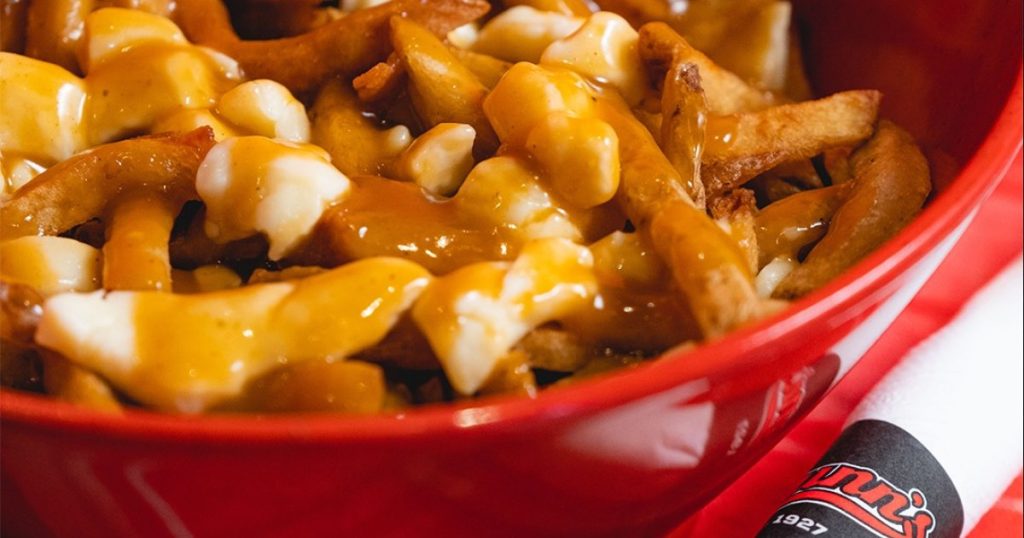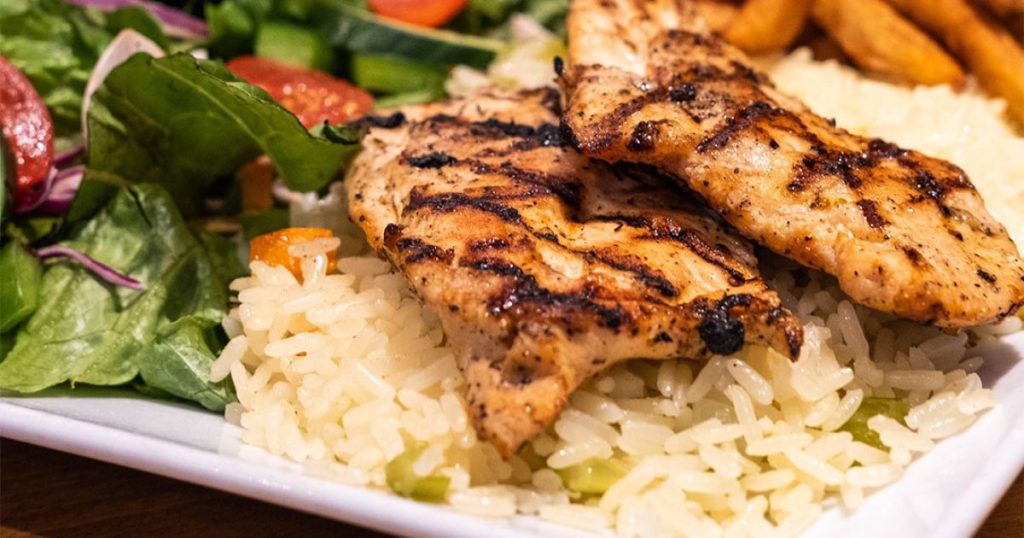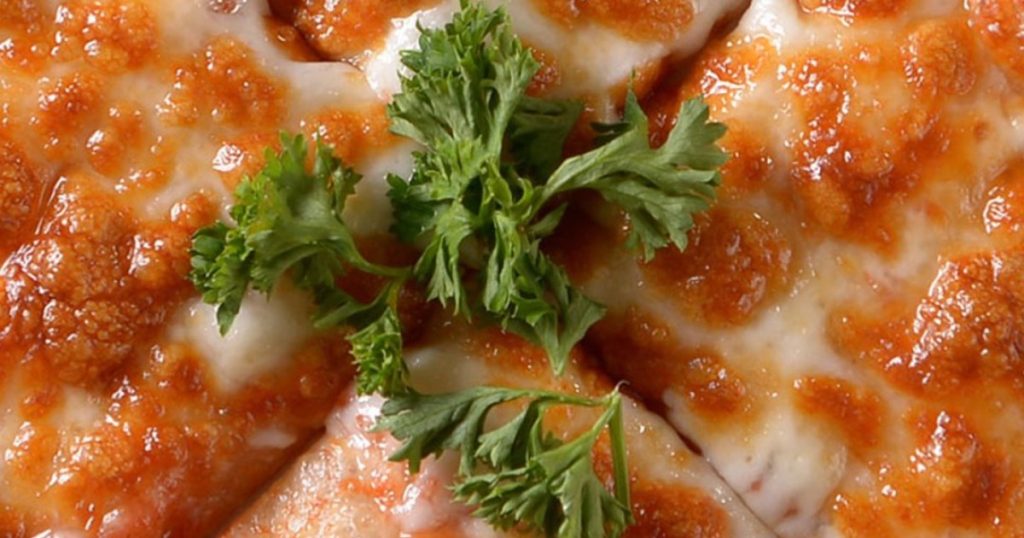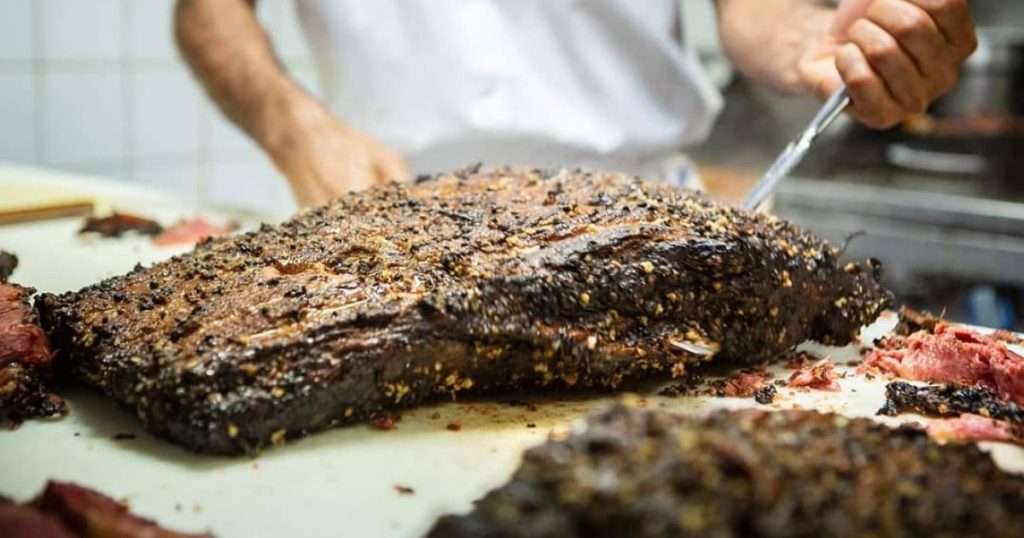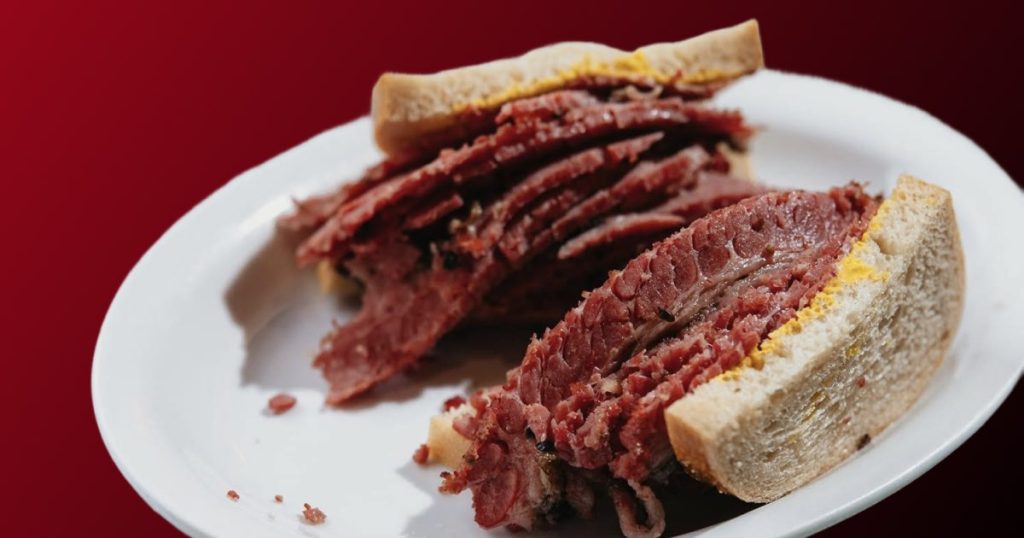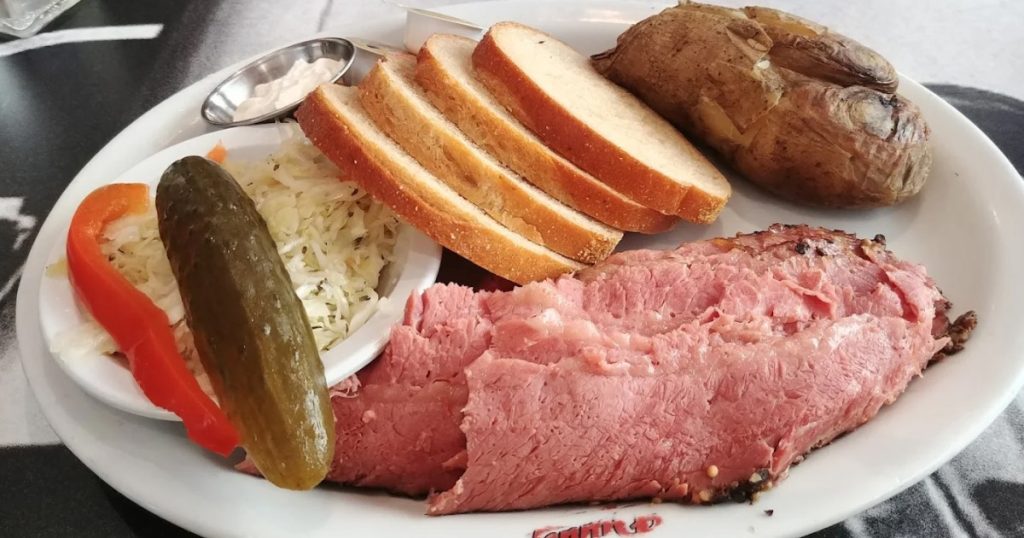You see it piled high on rye bread: thinly sliced, rosy beef. Is it roast beef? Or is it the legendary Viande fumée de Montréal? While these two look alike, treating them as the same is a culinary mistake.
They are fundamentally different foods. Roast beef is a simple, quick cook; Smoked Meat is a complex, multi-day process. The journey from cow to sandwich is the difference maker.
We’re here to settle the debate. The difference comes down to three key secrets: the specific cut of beef, the elaborate curing and spice rub, and the slow, unique smoke-and-steam cooking method. Let’s break down the rules that separate the Classic Roast from the Cured Masterpiece.
The Raw Materials: Where the Meat Comes From
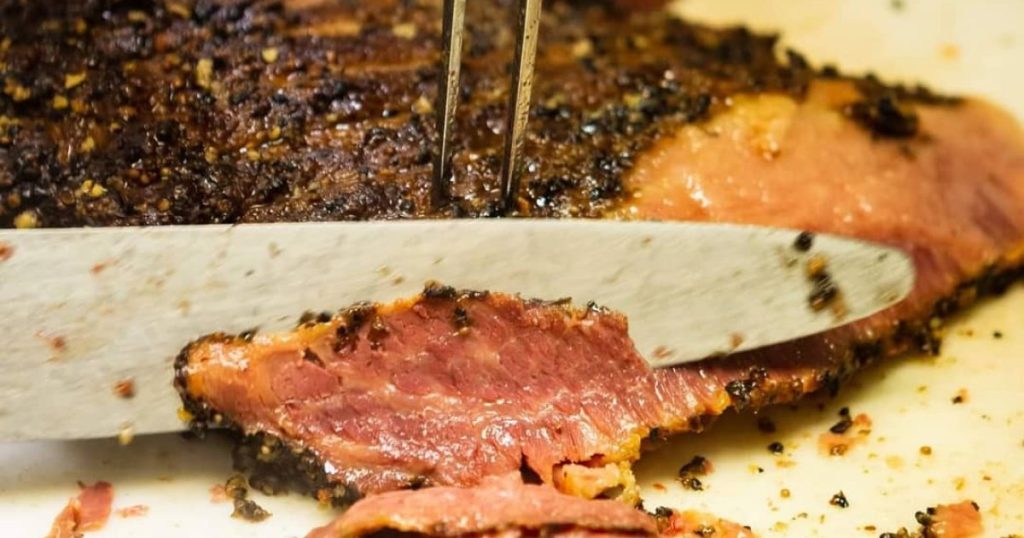
The first and most critical difference between these two meats starts with the butcher’s selection. A great sandwich is only as good as the cut of meat it begins with.
A. Smoked Meat: The Brisket Foundation
Montreal Smoked Meat almost always starts with beef brisket. Brisket is a large, tough cut taken from the chest area of the cow.
Why Brisket?
Brisket is full of fat and connective tissue, which might sound unappealing, but it’s essential. This tough structure allows the meat to withstand the lengthy curing and smoking process without completely drying out. The fat eventually renders down, creating the rich, moist, and incredibly flavorful finished product.
B. Roast Beef: Leaner, Quicker Cuts
Conventional deli roast beef, on the other hand, relies on cuts that are naturally more tender and less fatty.
- Common Cuts: You’ll typically find roast beef made from leaner joints like the Top Round, Sirloin, or a prime Rib of Beef.
- Why Lean Cuts? These cuts are chosen because they are suited for quick, dry roasting in an oven. They don’t need a lengthy process to become tender; they just need to be cooked to a specific internal temperature and sliced to maintain their inherent tenderness.
The Flavor Foundation: Curing and Spices
If the cut of beef is the body, the seasoning is the soul. This is where Montreal Smoked Meat pulls far ahead in complexity.
A. Smoked Meat
Montreal Smoked Meat is defined by its pre-cooking preparation, which can last up to two weeks.
- The Cure: The process begins with a long dry cure, where the brisket is rubbed with a mix of salt, sugar, and, most importantly, curing salt. This lengthy soak does two things: it preserves the meat, and it gives the beef its distinctive, uniform pink color, regardless of how well it is cooked. It also establishes a rich, salty base flavor.
- The Spice Rub: After curing, the meat is coated with a final rub. This blend is dominated by cracked black pepper and coriander seeds, often with strong supporting roles from garlic and mustard seed. The resulting flavor is intense, deeply savory, and highly aromatic.
B. Roast Beef
Roast beef keeps things simple, relying on the quality of the beef itself to shine.
- No Curing: There is no curing process. The seasoning is applied right before the meat goes into the oven.
- Simple Seasoning: The rubs are minimal and classic, typically just salt, coarse-ground pepper, and maybe some fresh herbs like rosemary or thyme. The goal is to create a delightful crust and enhance the natural taste of the beef, not to create a new, cured flavor.
The Heat Treatment: Cooking Method
This is the final, defining step that determines the texture of the finished sandwich. The goals for applying heat couldn’t be more different.
A. Smoked Meat: Smoke, Then Steam
The cooking for Smoked Meat is a two-phase operation designed to manage the tough brisket cut:
- Low-and-Slow Smoking: The cured and spiced brisket is first placed in a smoker for many hours at a low temperature (often below ). This process infuses the meat with the deep, complex smoky flavor that is the hallmark of Montreal Smoked Meat.
- Steaming for Tenderness: Crucially, the brisket is then steamed to finish. The steam rehydrates the meat and provides the moist, gentle heat needed to fully break down all the tough connective tissue. This results in meat that is incredibly moist, tender, and somewhat fibrous or stringy, perfect for hand-slicing.
B. Roast Beef: The Quick Dry Roast
The process for roast beef is simple and precise, aiming for a different texture entirely:
- Dry Roasting: The lean cut is placed in a hot oven and cooked with dry heat. The focus is entirely on controlling the internal temperature.
- The Medium-Rare Rule: The cooking stops immediately once the center of the meat reaches a target temperature (usually around 135°F or 57°C). The goal is a uniform slice of beef that is smooth, soft, and juicy, with a distinctly pink or red center.
Key Texture Difference: Smoked Meat gets its fibrous, moist, and tender texture from the steaming process, while Roast Beef gets its smooth, uniform, and soft texture from a controlled dry roast.
Serving Style and Presentation: The Final Plate
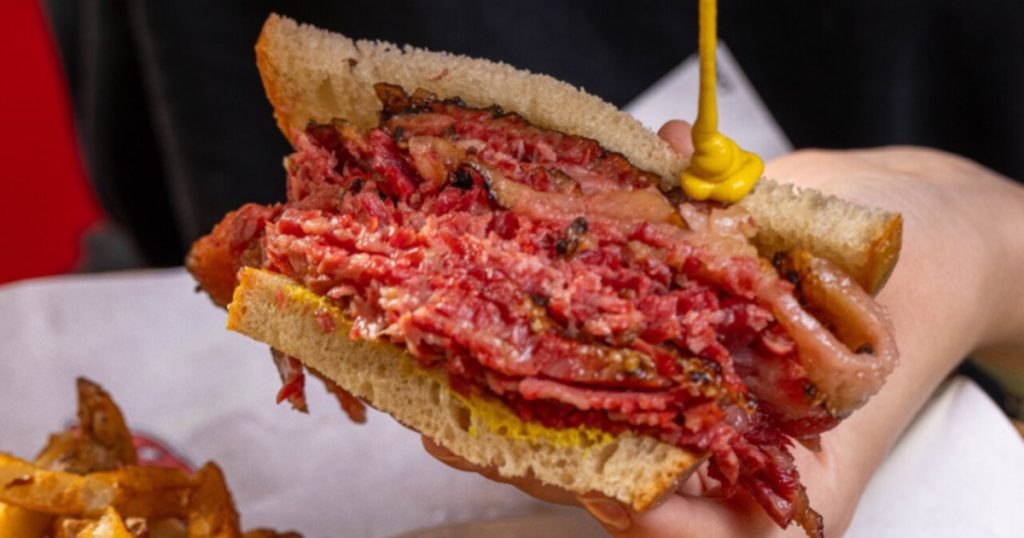
The preparation changes everything about how these meats are treated when they hit your plate.
A. Montreal Smoked Meat: The Hot Deli Classic
Montreal Smoked Meat is a specific, decadent culinary event:
- Temperature is Key: It is always served hot and steaming right out of the steamer. Serving it cold would cause the rich fats and juices to solidify, ruining the texture.
- Thick, Hand-Sliced: It is sliced thick and always by hand, against the grain of the brisket. This thick slice holds the spice rub and moisture, allowing the tender, stringy meat to practically melt in your mouth.
- Context: It’s the centerpiece of a meal, usually piled high on soft rye bread with moutarde jaune, served with fries and coleslaw.
B. Roast Beef: The Cool, Uniform Slice
Roast beef is versatile, acting as either a cool cold cut or a plated component:
- Temperature: It is typically served cool or cold to maintain its structure for thin slicing.
- Thin, Machine-Sliced: It is sliced very thinly and uniformly using a mechanical slicer. The smooth, consistent texture of the lean cut is ideal for this kind of precise presentation.
- Context: Used for cold-cut party platters, thin-sliced grocery store sandwiches, or served warm and sliced thickly as part of a plated dinner (like a Sunday Roast).
Conclusion
So, we’ve broken down the anatomy of the sandwich, and the mystery is solved. Roast Beef is a quick roast; Smoked Meat is a cured, smoked, and steamed brisket. One is fast, lean, and simple; the other is slow, rich, and complex.
If you’ve only ever had thin, cold, machine-sliced beef, you owe it to yourself to experience the real thing. To truly appreciate the effort that goes into a legendary Montreal Smoked Meat sandwich, you need to taste one piled high, hot, and hand-sliced.
Ready for the authentic experience?
Rendez-vous chez Dunn’s Famous and order a classic Montreal Smoked Meat sandwich. It’s the only way to fully understand the difference between a simple roast and a true cured masterpiece.
